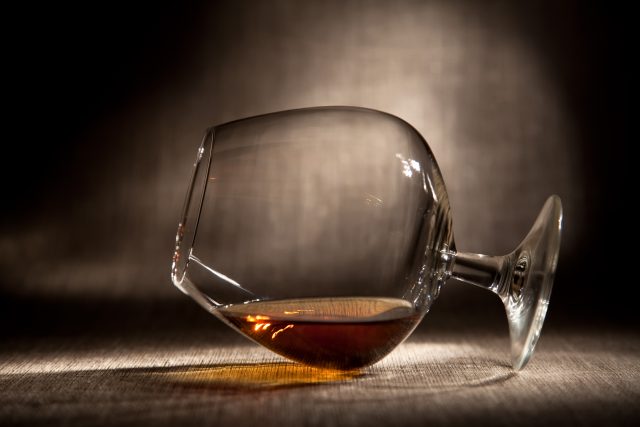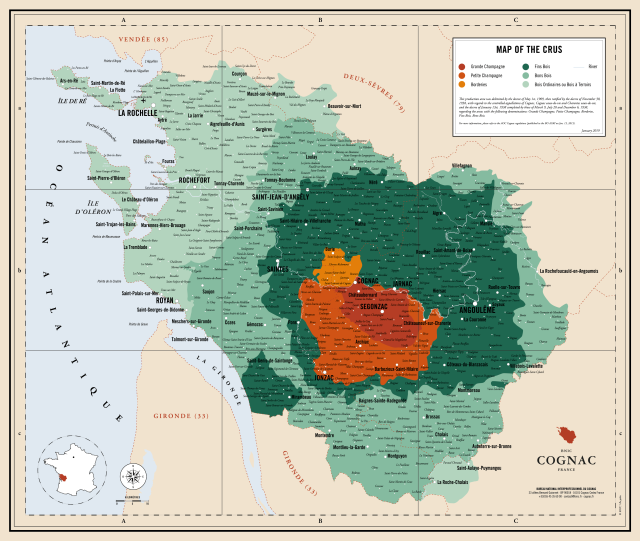What is Cognac?
In recognition of National Cognac day (4 June), db offers an introduction to some of the intricacies of this famous French spirit.

Geography
By its simplest definition, Cognac is a brandy originating from Western France’s Cognac region, which stretches from La Rochelle down to the Gironde. The region has been an Appellation d’Origine Contrôlée (AOC) since 1936, meaning that in order for a product to be labelled as ‘Cognac’, it must meet several strict regional requirements.
The region itself is divided into six grape growing zones, or crus. Those closest to the centre, Grande Champagne and Petite Champagne (‘Champagne’ is derived from the Latin term for field, ‘campus’, and not the wine region in the North-Eastern France), being considered to produce the best quality fruit. It is suggested that the calcareous soils in this area induce vine stress, increasing the flavour concentration within the grapes and, thus, creating an eau-de-vie with greater intensity. Across the entire Cognac AOC there are approximately 78,000 hectares of vineyards.

Grapes
The principle grape variety used for making Cognac is Ugni Blanc, also known by the Italian name ‘Trebbiano’. Its neutral flavour is an asset for prolonged periods in oak. Its large open bunches are also relatively resistant to fungal infections, such as powdery mildew.
The five other permitted grape varieties are: Colombard, Folle Blanche, Montils, Sémillon and Folignan (a crossing of Ugni Blanc and Folle Blanche). Producers are generally after fruit that is low in sugar and high in acidity. Both machine and hand harvesting grapes is permitted.
For producers who do choose to blend multiple varieties in the final product, it should be noted that each individual variety is vinified and distilled separately.
Distillation
As for the distillation itself – the low-ABV wine produced from the grapes is double distilled in Charentais copper stills.
The first distillation, or ‘premier chauffe’, produces a raw spirit known as ‘brouillis’, that is around 30% ABV.
The second distillation, or ‘bonne chauffe’, is divided into different fractions, ranging from the ‘head’ (around 80% ABV) down to the ‘tail’ (30% ABV) – the mid-fraction, known as the ‘heart’, is what will be placed in the barrel to age. The cut off point for the heart will vary from house to house. The heads and tails will usually be re-distilled with the next batch of brouillis. Most houses aim for an ABV of 40%.
Famed Cognac house Hennessy estimates that 12kg will produce nine litres of wine, which will produce three litres of brouillis through the first distillation, and one litre of eau-de-vie after the second.
According to the region’s regulations, distillation must be completed by 31 March. The clock then starts ticking, and Cognac that passes its second 1 April goes from ‘Compte 0’ to ‘Compte 1’. Cognac that passes a third 1 April is classified as ‘Compte 2’, etc.
If distilled after 31 March, the Compte ageing system dictates that the spirit will remain at ‘Compete 00’ until the following 1 April, when it will finally be elevated to Compte 0 status, and to Compte 1 a year after.
Maturation
When it comes to barrel ageing, there are two species of oak to consider: Quercus pedunculata (osourced from the forests of the Limousin) and Quercus sessiliflora (from the Tronçais forest in Allier). While Q. pedunculata contributes a red hue and vanilla aromas, Cognacs aged in Q. sessiliflora casks tend to be more amber with a subtle coconut flavour.
Partner Content
Barriques (250-300 litres) are the typical size of vessel used for maturation. Both old and new vessels are used, and houses may transfer the spirit between casks in order to change how the spirit ages.
Barrel location also matters – Cognacs aged in more humid cellars, such as those on the banks of the Charente, will generally mature at a slower pace than those in drier conditions. This is because the greater the concentration gradient between the contents of the barrel and the outside, the greater the rate ethanol and water will evaporate – otherwise known as the ‘angel’s share’.
The issue of where the Cognac is actually aged can be controversial. ‘Early-landed Cognac’ refers to Cognac that has been partially-aged within the Cognac AOC, and then transported in its cask to another location, possibly another country, to continue maturation and, eventually, be bottled. One popular destination for early-landed Cognac was the port of Bristol, in the west of England. While still permissible, early-landing Cognac is a rare occurrence today. 98% of Cognac produced is exported internationally, but already bottled, rather than in its barrel.
There are four levels of Cognac maturation to keep in mind when choosing a bottle, and they will be indicated on the label as follows:
- VS (Very Special) – the youngest spirit in the blend was barrel aged for at least two years
- VSOP (Very Special Old Pale) – the youngest spirit in the blend was barrel aged for at least four years
- XO (Extra Old) – the youngest spirit in the blend was barrel aged for at least 10 years
- XXO (Extra Extra Old) – the youngest spirit in the blend was barrel aged for at least 14 years
Most Cognacs put on the market are blends of spirits of various ages, both for cost and house style reasons, but vintage expressions are also bottled.
Taste
Younger spirits will likely display fresher aromas of flowers (jasmine, rose, etc.), stone fruits (peach and apricot),
Older ones will typically reveal greater aromatic influence from their prolonged time in wood, with more spice (cinnamon, clove and nutmeg), dried fruit (raisin and dried fig), and nuts (walnut and hazelnut).
One key flavour group of older Cognacs (usually with at least 10 years of age) is ‘rancio’, a Spanish term for desirable flavours of decay. These can range from truffle to tobacco to forest floor.
Longer periods in oak will also lead to a greater concentration of tannins, leached from the wood, in the final spirit.
Serving
The general consensus is to consume Cognac neat, at room temperature, in some form of stemmed brandy glass.
As with most spirits, it is suggested not to swirl it as that will encourage the evaporation of alcohol, leading to a burning sensation on the nose.
Cognac is also used in mixology. One popular cocktail that utilises the brandy as an ingredient is the Sidecar, which combines Cognac with triple sec and lemon juice. It can also be used in a classic Sazerac as an alternative option to whiskey.
Related news
The biggest fine wine auctions of 2025




